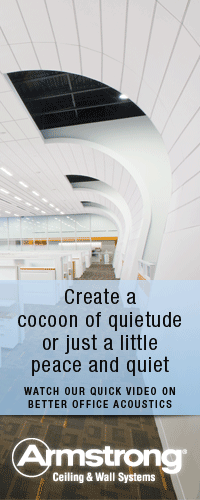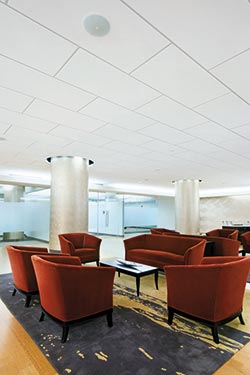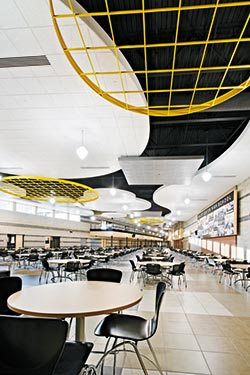Retrofitting Acoustically Challenged Spaces
Choice of ceiling treatment can improve the acoustic environment
of existing closed plan, open plan, and open plenum spaces
 According to research at the University of California at Berkeley’s Center for the Built Environment, the level of dissatisfaction with acoustic quality makes acoustics the lowest performing Indoor Environmental Quality factor in all buildings surveyed. According to research at the University of California at Berkeley’s Center for the Built Environment, the level of dissatisfaction with acoustic quality makes acoustics the lowest performing Indoor Environmental Quality factor in all buildings surveyed.
Fortunately, improving the acoustic environment of existing closed and open plan layouts as well as open plenum spaces is not difficult as long as attention is paid to key areas such as the ceiling. In that regard, here are some general guidelines for retrofitting spaces with poor acoustics.
Closed Plan Spaces
A common cause of poor acoustics in conference rooms and executive offices is the transmission of sound between adjacent spaces, especially when the spaces share a common ceiling plenum. Achieving speech privacy between spaces is the goal.
If a suspended ceiling is already in place and there are noise issues, the Noise Reduction Coefficient (NRC) of the ceiling panels is probably under 0.70. Replacing standard ceiling panels with panels that have an NRC of 0.70 or higher will improve acoustics.
If partition walls only go up to the ceiling, and not to the deck, install mineral fiber ceiling panels that have both an NRC of 0.70 and a Ceiling Attenuation Class (CAC) of 35 to 40. This combination will provide speech privacy along with improved sound quality within the space. Choose the lower rating if masking sound is used; the higher rating, if not used.
Armstrong offers a number of excellent ceiling options that meet these criteria, including both Ultima® High-CAC and Cirrus® High-CAC Ceiling Systems.
Open Plan Spaces
In open plan spaces, the main benefit of the ceiling is the absorption of sound that would normally bounce off hard surfaces into nearby spaces or cubicles, causing intrusive distractions. If a suspended ceiling is already in place and there are noise issues, the NRC of the panels is likely under 0.70.
To achieve a high level of sound control and to reduce distractions, install fiberglass acoustical ceiling panels that have a high Articulation Class (AC) rating. For knowledge workers, choose an AC 200 or higher; for clerical workers, choose an AC 170 or higher. Excellent choices from Armstrong include both its TechZone and Optima® Ceiling Systems and SoundScapes® products.
 |
 |
Ultima® High-NRC ceilings from Armstrong can absorb 80% of the sound that strikes them. |
|
Formations™ Acoustical Clouds from Armstrong help reduce reverberation in open plenum spaces. |
|
Open Plenum Spaces
In open plenum designs, acoustical considerations are often abandoned in favor of the aesthetics provided by an exposed structure, which leads to problems with noise and reverberation. Sound reflecting off the exposed deck generally results in excessively loud and “lively” spaces.
Many noise issues in these spaces can be addressed through the installation of discontinuous sound-absorbing ceiling systems designed specifically for that purpose. The Armstrong family of Capz™ ceilings, for example, is a simple, affordable way to retrofit exposed structure spaces.
All Capz systems are offered in a wide variety of standard sizes, providing an extensive choice of layout options. The panels can be installed in long runs, grouped in sections, or placed individually, all based on the acoustic and aesthetic needs of the space.
“Free-Floating” Options
Noise issues related to open plenum designs can also be addressed through the use of acoustical clouds, canopies, baffles, and blades — four types of “free-floating” options that add sound absorption while still allowing for the exposed look.
These four options all absorb sound on both their front and back surfaces. As a result, they actually provide greater sound absorption than a continuous ceiling of the same surface area.
Formations™ Acoustical Clouds and SoundScapes® Shapes Acoustical Clouds, both from Armstrong, suspended above work areas provide a type of interrupted ceiling plane. As such, they help control distant reverberation and reflections between cubicles, reducing occupant annoyance and distractions.
SoundScapes Acoustical Canopies also help reduce reverberation, but are much different in size and look compared to acoustical clouds. Visually, acoustical clouds are flat, while canopies are curved and can be installed as hills and valleys.
Vertically hung Soundsoak® Baffles and SoundScapes Blades from Armstrong also provide substantial sound absorption. Installation is easy because all of the components needed to mount a baffle or blade are contained in a hanging kit.
Visit Acoustic Website
If you would like to learn more about improving the acoustics of either closed plan, open plan, or open plenum spaces, visit armstrong.com/acoustics. The site includes charts showing “Good,” “Better,” and “Best” ceiling solutions for a space, and allows visitors to actually hear the difference a ceiling treatment can make. You can also contact Armstrong TechLine℠ experts for help with an acoustical solution to fit your needs at
bpotechline@armstrong.com or 1- 877-276-7876, press 1.
Information courtesy of Armstrong
|
